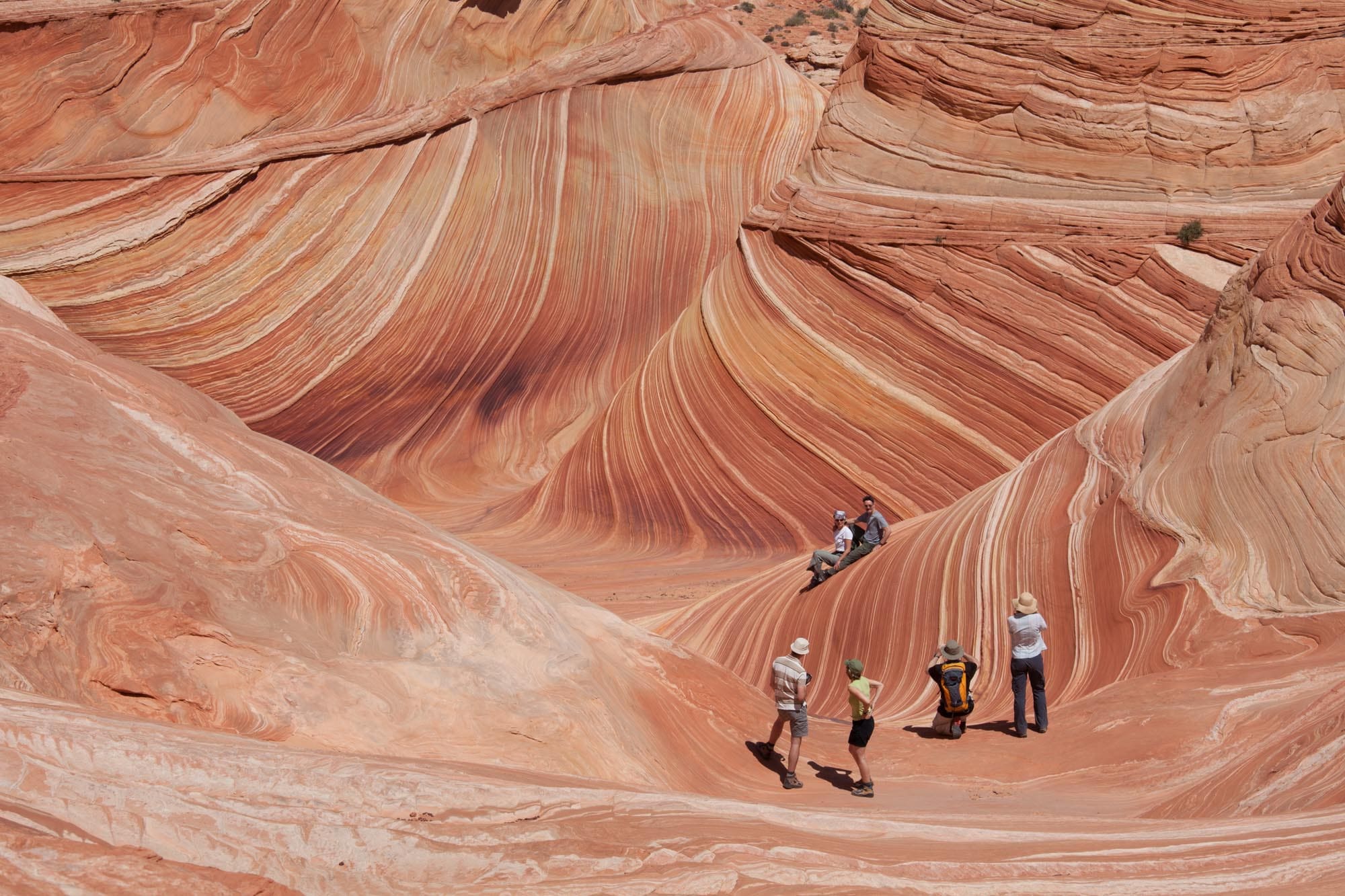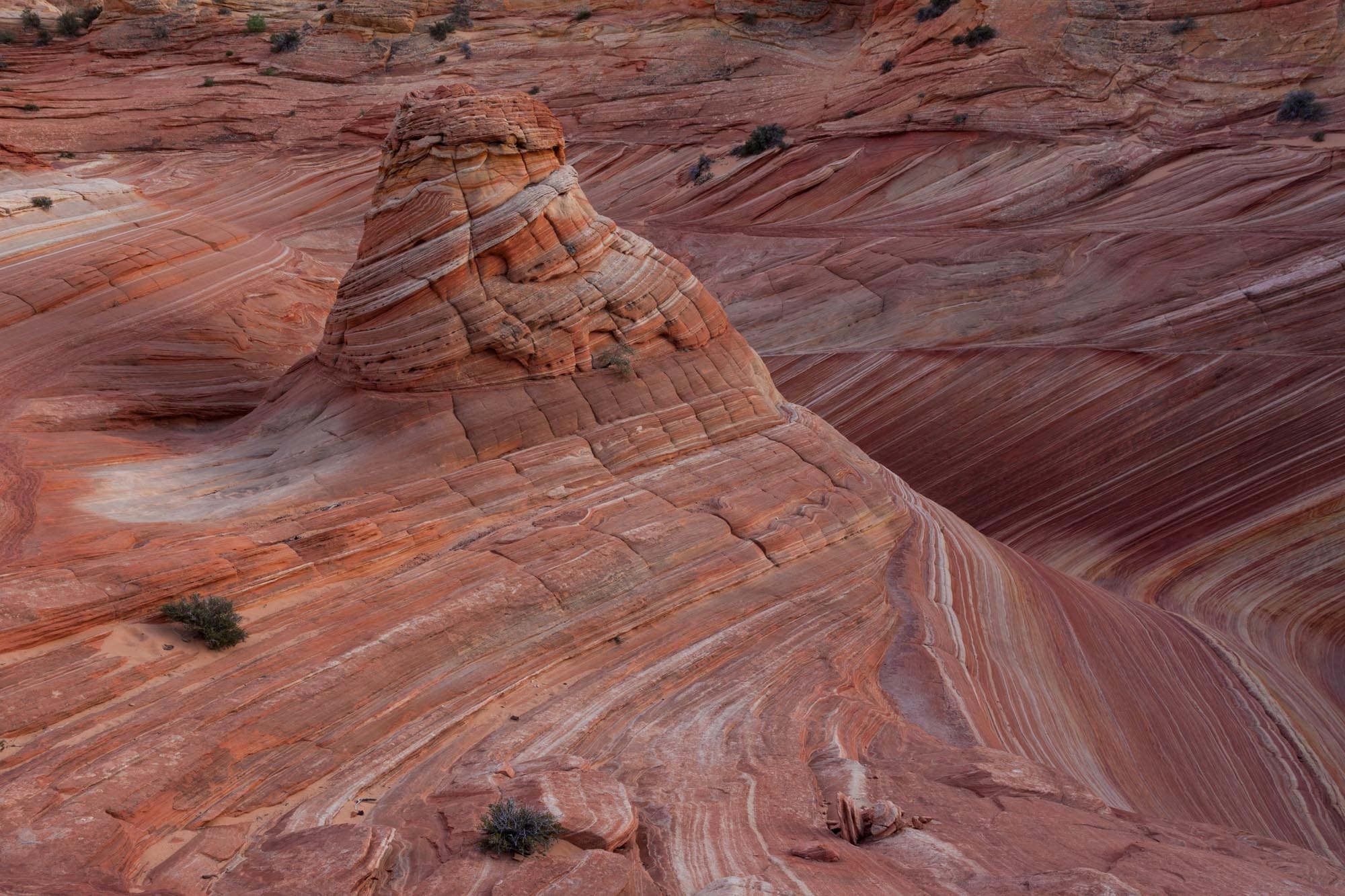It’s been so long since I’ve been on a proper trip I feel the need to stroll down memory lane and re-live one of my favorite photographic experiences. I’m inspired to share this story as it’s about photographing an iconic location on many photographers’ bucket list. And this photographic adventure was a very memorable experience for me.
Location: The Wave

Unusual land formations in southern Utah and northern Arizona are a dime a dozen. One of the most interesting, and most photogenic is a rock formation that resembles an ocean wave. From an experienced photographer’s point of view it is a visual playground with as many possibilities as you have ideas.
The Wave is located in northern Arizona but is accessed through Utah in a remote and desolate region known as the Paria Canyon-Vermilion Cliffs Wilderness. Part of what makes it a highly desirable location is the difficulty getting to it. It’s a long way from the nearest airport, far from any sizable city, down a difficult dirt road, and through an unforgiving desert; that’s not even the hard part. The real challenge is getting a permit through the Bureau of Land Management (BLM).
Unique permit process
Due to the fragile nature of The Wave and the environment surrounding it, only 20 people are issued permits to visit the site each day. The first of two ways to score your permit is through an online lottery held three months in advance. Ten visitors, out of most likely thousands of entries, will then be able to plan their trip well in advance. If you have a thought to go online and enter every day until you win a spot, you may want to rethink that. Each daily entry in the lottery will cost you $5.00.
The second way in which to get a permit is to show up at the BLM office in Kanab, Utah and enter the in-person lottery. The in-person daily lottery will often have 50 to 150 entries for the remaining 10 permits. The mid-morning results are for permits for the next day. Many folks, like myself, will set aside a number of days to try for the lottery. I had set aside four days and was lucky enough to win a spot on my third day. Phew! Not all are so lucky; one dedicated traveler from Asia had entered the lottery every day and had still not won a spot after four months.
One of the problems with entering the in-person lottery every day is that it kind of ruins having any other big plans for the day. With the region being so big, you can’t stay too far out of Kanab to make to the office by the morning lottery. By the time the lottery is over the heat of the day is just starting to set in, foiling any morning plans.
My creative plan
I wanted to make the most of my 1-day permit, but was hesitant to spend too much time out in the mostly shadeless environment; temperatures were expected to reach 100ºF (38ºC). While I had scouted the location thoroughly online I wasn’t sure when the best light would be.
My ingenious idea was to hike out in the pre-dawn light with an arrival around sunrise. Few make the trek this early so it would allow me to have the run of the location for a while. I would stick around until it started to get warm. I’d then hike out, go to my nearby camp and rest during the heat of the day before hiking back out in the evening.
The problem with my plan is that I’d have to hike the unmarked route in near darkness. Despite a few navigation errors I arrived on site at 7am. To my surprise I noticed another person that had already beat me out there. Strange I thought, as there were no other cars in the designated parking lot. As I made my way in their direction, they disappeared into the rocks. Over the next hour I caught periodic glimpses of them behind different rocks. It’s my summation that this person did not have a permit and had hiked out from a different location hoping to beat the crowds. The fine if caught without a permit in the area is $5,000.00. They might have worried that I was a park ranger.
Photographing The Wave – Morning
The Wave is not really a sunrise or sunset location. Photographing this particular iconic location can work well in full sunlight or full shade. With my early morning arrival it was currently in full shade and would be for some time. This allowed me time for what I like to do with any new photographic environment — give the location a full exploration before shooting any photos. Once I scouted all the best angles I proceeded to work my way from location to location using all the lenses in my arsenal.


For almost three hours I had The Wave to myself before the first of the remaining 19 permit holders started to show up. Those were three really good hours; after all, how often do you get that much solitude at a landmark location? Once they arrived I used my time to explore other areas nearby that were also interesting. At about noon it was time for me to hike back the 3+ miles to the car and then onto camp.


Photographing The Wave – Evening
My evening return was much quicker, now that I knew the way and I arrived back at The Wave at 6:30pm; giving me about 90 minutes of sunlight to work with. A few permit holders were still at The Wave, but left soon after to avoid hiking in the dark. That is something I would have to deal with later.

Once again I had The Wave to myself and was able to work my way around the scouted locations from earlier in the day, trying to make use of the warm evening glow. My plan wasn’t only to make use of the evening light but to also stick around for some astrophotography. What I had not considered was the amount of time from last good light (7:45pm) to good darkness for star shooting (9:45pm). Two hours is a long time to sit around on your own with nothing to photograph. I wish I had brought a book because there was nothing left for me to do in this in-between time of light.
Once the stars became easily visible I started in with the long exposures. My secret weapon was the 24mm f/1.4 lens that was my favorite for nighttime shooting. Once I figured out my compositions I pulled out my flashlight to add a bit of fill-light to the foreground rock formation. It took me more than an hour of painting with the light to get an exposure I was happy with. By the time I felt like I had captured everything I could, it was 11:30pm. The hike out wasn’t the issue that I thought it might be, seeing how it was the third time I had travelled the route in the previous 18 hours. As I drove back to my camp I was exhausted. I had hiked more than fourteen miles and spent several hours of photographing the iconic location, but was thoroughly satisfied that I’d squeezed as much out of the experience as I could.

Shooting iconic locations: good or bad?
Some people shun popular locations, especially ones requiring permits. I too have had dubious thoughts about locations that have been too well documented. But I’m not deterred by the fact that someone else has been there before me. If I chose to think like that, I’d never be happy. Don’t be concerned if it’s too popular or overdone; make your experience unique to you. As long as you enjoy your time, experience and photography, and perhaps learn something along the way, it makes not one bit of difference who has been there before you.
Interested in travel? Check out the Travel Photography Essentials class.
Become part of John’s inner circle
Sign up for the newsletter here – it’s free.
Want to become a better photographer?
Check out John’s selection of photography and camera classes here.



